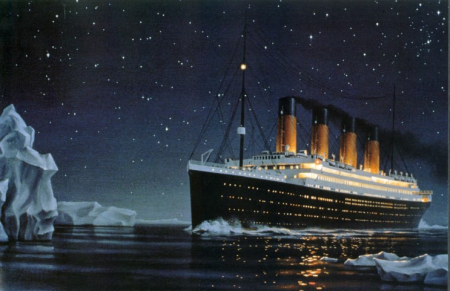April 14, 1912
The date of April 14th is the single most important and most memorable of all for the R.M.S. Titanic. This date in history is one that has made historians discuss and speculate about it for the entire past century! Are you ready?
This was the fifth day of the Titanic's journey and it was no different than the previous days. Passengers were enjoying sitting on the deck, feeling the cool breeze on their faces, lounging about inside the giant ship, passing time away. It was late at night when the catastrophe began---if the Titanic had reached this exact spot in the daylight, instead of in the black of night, I'm sure the catastrophe would have been avoided completely! As it was, hundreds of people were already in bed for the night, but other hundreds were still up and awake, partying in the grand dining rooms and lounges.
I have found
4 particularly interesting facts about this day of the 14th.
 A lifeboat drill was scheduled
A lifeboat drill was scheduled, for this very day, April 14th...
yet was cancelled! All passengers, deckhands, and officers were to participate in this drill, but for some reason, the Captain cancelled it. This is almost an unbelievable fact that it happened on the same day that the Titanic would need the lifeboats!
 7 telegrams were received
7 telegrams were received that day, which warned of icebergs that other ships had encoutered in the same area that the Titanic was passing through. If the Captain would have pieced together the latitude and longitude markings together from each message, he would have realized that they were driving straight through a packed ice field. However, this fatal mistake was not his own---the men in the wireless room failed to send these telegrams to him.
 April 14th was a Sunday
April 14th was a Sunday that year in 1912. Somehow, I think this adds character to the story of the Titanic. To quote from Stephen Hines' book on the subject, he said:
"many religious commentators of the day came to the conclusion that the loss of the Titanic was ordained of God to punish the pride of Modern Man in his overconfidence in technology and the Mighty Machine." This is course, just an opinion from what certain people felt.

Captain E.J. Smith presided over an Anglican service that Sunday, in the First Class dining area. All of the classes, even steerage passengers held their own church services on this fateful day.
This was the last church service many of the passengers would ever attend.
On the night of the 14th, the ship glided through cold, still water. The ocean remained silent; no waves. The Titanic was traveling through an giant ice field at full speed. Because there were no waves of water breaking on the base of any surrounding icebergs, the quiet maze of floating ice was harder to see.

At
11:40pm, there was a thump that resounded throughout the rooms and hallways of the giant vessel. The unexpected movement and sound was over in a moment, and went unnoticed by many. It would hardly seem that such a little thing could stop an unsinkable ship, so the people who did notice the slight interruption, simply went back to whatever they were doing. The silence that followed is actually what rendered more of a response from the people aboard. After so many days at sea, and hearing the engines constantly rumbling beneath their feet, sudden silence now engulfed the ship; the quietness in itself was more emphatic. Only 37 seconds before, the two men who were in the ship's crow's-nest had seen a giant iceberg approaching.
Only 37 seconds were given to save thousands of peoples' lives! In this small increment of time, one of the lookouts named Frederick Fleet phoned down to the
bridge (the commanding room) and the following conversation took place:
"What did you see?" asked a calm voice at the other end.
"Iceberg right ahead," replied Fleet.
"Thank you," acknowledged the voice with curiously detached courtesy. Nothing more was said.
('A Night to Remember' by Walter Lord, page 14)
There was quick thinking involved for the men in the bridge. They couldn't just stop the Titanic, because if you remember from her sea trials, a ship so enourmous in size took about 3 minutes to stop. The only things that could have been done was to either hit the iceberg straight on, or attempt to swerve away. The seconds ticked by while the two lookouts in the crow's-nest waited for the ship to turn, but it took time. Finally, the front end of the Titanic seemed to be turning to the left, away from the menacing block of ice that stood even 100 feet above the Titanic's deck. As the ship kept moving, continually turning to the left, the iceberg sat on the right, scraping all along the side of the ship. In fact, the portion of the iceberg on top of the water didn't even hit the Titanic---it was the other 90% of the iceberg underneath the surface which was scraping the Titanic's hull.
Each of the first 5 watertight compartments were punctured from underneath the water. It wasn't a continual gash, but rather a line of smaller gashes that let the ocean water flood into each of the 5 compartments. The jagged ice scraped the steel hull as the Titanic kept turning left, away from the impact.
Just like that,
the Titanic was doomed. The ship's own designer, Thomas Andrews, was on board for the first voyage. He knew the Titanic better than anyone, and his own estimate was that between an hour or two was all that the Titanic had left. The 16 watertight compartments that made the ship 'unsinkable' were filling up much too quickly with ocean water.
When this realization came upon the men in charge, they knew they should start making preparations for the sinking.
There were 3 things to attempt:

Fill the lifeboats with passengers to get them away from the ship.

Get in contact with other ships via telegrams, requesting rescue.

Launch distress rockets into the sky, to grab the attention of nearby ships.
These are the very 3 things that Captain Smith and the officers aboard the Titanic were doing, once they discovered that there was no possible way to save their ship. At first, I'm sure the realization came over them slowly, because in their minds, they were traveling on the largest ship in the world, built with some of the best safety features, and the ship was brand new, on her very first voyage.
By the time midnight arrived, and the clock turned over to April 15th, the lifeboats were being loaded.
"Women and children first!" was called out over the decks. Thomas Andrews, Captain Smith, and the other men in charge now not only faced the destruction of the grandest ship ever built, but also the dread of knowing that there was nowhere near enough lifeboats for the capacity of passengers on board.
The rest of the night's story continues tomorrow in part 2 of the sinking.
How would you have felt, being stuck way out in the ocean like that? On a dark night, in the coldest temperatures of water?



 Violet Jessop worked on several ocean liners during her lifetime as a stewardess and nurse. The thrilling fact was that she served on all 3 of White Star Line's Olympic-class ships... and more specifically, she was on each one when it wrecked. She survived each incident! Violet Jessop was on the Olympic, the first of the 3 sister ships, on September 20, 1911, when it collided with a cruiser called the HMS Hawke. I should also mention that Captain Smith was commanding this ocean liner at the time. The Olympic did not sink due to the wreck, but was badly damaged. The ship was able to return to England to be repaired. Violet Jessop was on the Titanic when it struck the iceberg on April 14, 1912. She survived the Titanic, only to continue on with her service with White Star Line's next big vessel. Violet Jessop was on the Britannic when it wrecked and sunk on November 21, 1916. Again, she survived. She didn't die until 1971, when she was 83 years old. I found her story to be immensely interesting!
Violet Jessop worked on several ocean liners during her lifetime as a stewardess and nurse. The thrilling fact was that she served on all 3 of White Star Line's Olympic-class ships... and more specifically, she was on each one when it wrecked. She survived each incident! Violet Jessop was on the Olympic, the first of the 3 sister ships, on September 20, 1911, when it collided with a cruiser called the HMS Hawke. I should also mention that Captain Smith was commanding this ocean liner at the time. The Olympic did not sink due to the wreck, but was badly damaged. The ship was able to return to England to be repaired. Violet Jessop was on the Titanic when it struck the iceberg on April 14, 1912. She survived the Titanic, only to continue on with her service with White Star Line's next big vessel. Violet Jessop was on the Britannic when it wrecked and sunk on November 21, 1916. Again, she survived. She didn't die until 1971, when she was 83 years old. I found her story to be immensely interesting!










